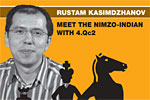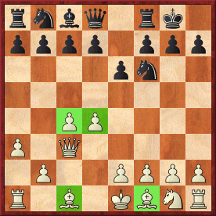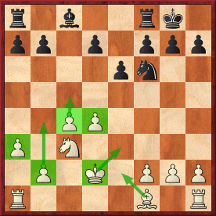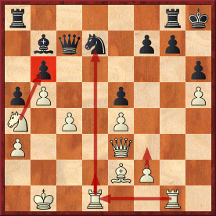



Meet the Nimzo-Indian with 4.Qc2 (DVD), by Rustam Kasimdzhanov, ChessBase, Video running time: 3 hours 28 min. $32.95 (ChessCafe Price: $26.95)
The Nimzo-Indian Defense, 1.d4 Nf6 2.c4 e6 3.Nc3 Bb4, is a hyper-modern opening developed by grandmaster Aron Nimzowitsch. The basic premise is to prevent White from playing e4 by pinning the knight on c3 and possibly to double White's pawns after Bxc3. This DVD is by grandmaster Rustam Kasimdzhanov (pronounced "Kah-zeem-jha-nov"), who was the FIDE Knockout World Champion in 2004. He examines the Classical Variation with 4.Qc2, with which White aims to spoil Black's plan of doubling pawns by recapturing with the queen.
There was some initial trepidation of the content based on some editing mishaps by the publisher, in that from the back cover of the DVD we have the following promotional blurb:
"Rustam Kasimdzhanov, the FIDE World Champion in 2004, is pre-destined to deal with the subject of the Nimzo-Indian with 4.Qc2, since he has been extremely successful with this opening both with White and with Black. The Usbek grandmaster has also gathered valuable experience on the subject when working as a second to world champion Anand. Right from his introduction, Kasimdzhanov emphasises that the Nimzo-Indian has a lot of advantages and that White is often left with a ruined pawn structure; that is precisely what the queen move avoids. Of course in his investigations the author offers much deeper insights into the opening. In over four hours of video [emphasis added] Rustam Kasimdzhanov explains all the important ideas, strategies and tricks helped by sample games in which the white side is represented, e.g., by Kasparov, Anand, Kramnik and Ivanchuk as well as the author himself."
But then the paragraph ends with bold red lettering "Video running time: 3 hours 28 min," which is accurate and, of course, less than four hours of video. The next flag was the introductory text file in the ChessBase database named "Meet the Mimzoindian [sic] with 4.Qc2." Thankfully, these slips were not indicative of the training material to follow.
Kasimdzhanov goal is to provide a "proper repertoire against the Nimzo-Indian"; a fact he emphasizes at least three times in the two-and-a-half minute introduction. After 1.d4 Nf6 2.c4 e6, he calls 3.Nc3 the most natural continuation and notes that the problem for most amateur players, as well as professionals, is that 4.Nf3 can transpose to too many different openings. He notes 4.Nc3 limits the opponents choices, but then leaves White facing the question about what to do upon 3...Bb4. His own choice of course being 4.Qc2. Kasimdzhanov promises an overview of the theory as it stands now and many practical examples from recent games; though the four most recent games are from 2011, with the others spanning from 1999 to 2008.
The contents are divided as follows:
Of the eighteen video segments, twelve are devoted to game presentation and six to outlining the theoretical material. The longest game clip is Kasimdzhanov-Karpov at almost twenty-one minutes. The longest theory segment is on 4...0-0 and runs just over twelve minutes. However, the theory segments are only introductions to the basic themes and plans; there is plenty more theory in the game presentations.
In the introductory theory segment, Kasimdzhanov devotes nine-and-a-half minutes to the basic principles of the line. He calls 4.Qc2 "a bit easier to play, a bit easier to understand, and a bit healthier in general." He notes that Black's replies are limited to three or four continuations, with the heart of the variation being 4...0-0 5.a3 Bxc3 6.Qxc3, when White has a strong pawn center and the bishop-pair; with the drawback that Black is already ahead in development.

He then gives a brief overview of 6...b6 7.Bg5 Bb7, which he calls the main tabyia of the whole line and 6...d5 7.Nf3 dxc4 8.Qxc4 b6 9.Bg5. So much for the maxim don't bring your queen out to early! Kasimdzhanov later notes it is easier for White to build a long-term repertoire from 5.a3 than from 5.e4.
The other mainline is 4...d5, which stops White from playing e4, when 5.a3 can transpose to the line above after 5...Bxc3+ 6.Qxc3 0-0 or Black has 6...Ne4 7.Qc2 c5 8.dxc5 Nc6, which he calls "another very, very major position." White also has 5.cxd5, with Black now having the choice between 5...exd5 and 5...Qxd5.
During the presentation Kasimdzhanov is articulate and comfortable in front of the camera, though he does speak with many verbal pauses ("uhs"). He often seems to steer the viewer away from overly complex speculative lines to solid variations that offer a slight pull for White. At one point he comments "If Black loses control over e4, White's advantage will probably become overwhelming."
Kasimdzhanov begins by looking at the minor lines before moving on to the critical variations. He is quickly dismissive of these and often ends with an assessment that White has easy play after only a handful of moves. However, he does not explore them too deeply and if you find yourself in one of these situations, you may be wishing for Kasimdzhanov's level of skill to capitalize on the "easy play" you are supposed to be enjoying. One of the longer lines he looks at is 1.d4 Nf6 2.c4 e6 3.Nc3 Bb4 4.Qc2 c5 5.dxc5 0–0 6.a3 Bxc5 7.Nf3 Nc6 8.Bg5 Nd4 9.Nxd4 Bxd4 10.e3 Qa5 11.exd4 Qxg5 12.Qd2 Qxd2+ 13.Kxd2

He notes that the line has fallen out of favor with Black because White has an enjoyable endgame. This may well be true, but, again, a player needs the skill to make the most of the position. A player serious about improving may decide to play out this position repeatedly against a friend or computer to see how they fare. As Kasimdzhanov notes, in reference to a different position, a deeper understanding of the resultant positions will do no harm.
One of the things that I liked is that when you click on a game link in the ChessBase text file, it jumps to the position of the variation under discussion. This saves time for the viewer by not having to watch the presenter click through the opening moves to arrive at the desired position. I also like the fact that Kasimdzhanov includes the complete game scores. Moreover, whenever an important position is reached he stops to explain the theoretical underpinnings and the relevant variations in some detail, while also pointing out the tactical shots hidden in the position.

The coverage mostly highlights the dangers of Black's position, such that you may wonder how it is that Black ever wins a game, especially given that the twelve complete games on offer are all White wins. Given the nature of this opening, I would advise the prospective player to watch as many of the video segments as possible before venturing it over the board; certainly watch all the theory clips and several of the game clips. But then have at it and enjoy! Meet the Nimzo-Indian with 4.Qc2 is a very good introduction to this complex opening. It arms the viewer with the necessary knowledge to confidently include this variation in their repertoire.
My assessment of this product: Good (four out of six stars)